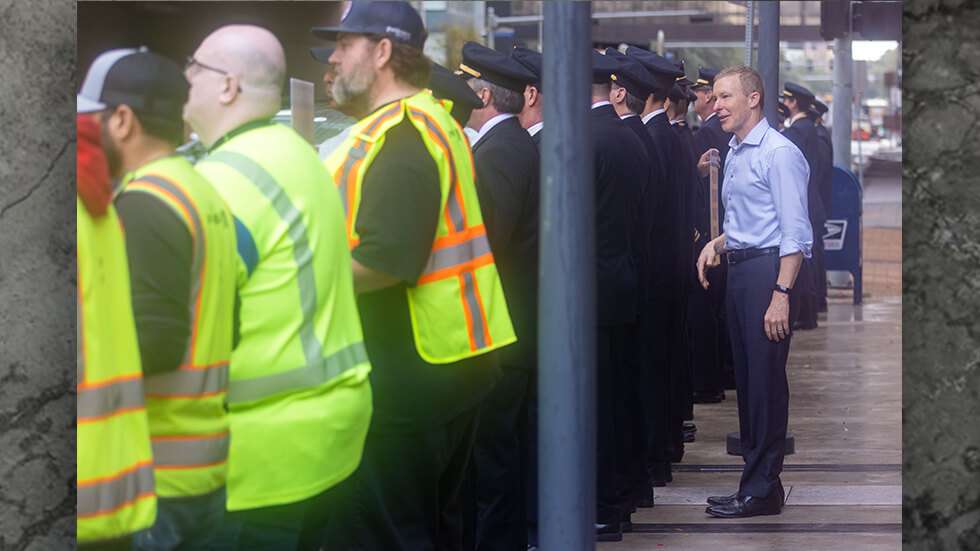Supreme Court Strikes At Federal Experts

Supreme Court Strikes At Federal Experts
WASHINGTON – On June 28, 2024, the U.S. Supreme Court issued a landmark decision that will drastically alter the government’s ability to enforce workplace safety, aviation standards, and commercial flight operations. This ruling, which ends the Chevron deference doctrine, hamstrings the efforts of agencies like OSHA, the FAA, and others to carry out their regulatory duties.
Chevron deference, established by a 1984 Supreme Court case, allowed courts to defer to federal agencies’ interpretations of ambiguous laws. This was crucial because judges and juries typically do not possess the same level of expertise as the specialists within these agencies. The doctrine enabled experts in various fields to use their knowledge to guide federal agencies and make binding decisions, leading to more informed and quicker regulatory outcomes. Removing Chevron deference means judges will now make binding decisions on subjects they may know very little about, which could lead to inconsistent and prolonged rulings.
For example, instead of deferring to OSHA’s requirements, a judge and jury might now decide if electric tugs are parked too close to a fire exit or if there are enough first aid kits. Similarly, decisions on whether to add or remove fire extinguishers or mandate CPR training could now be subject to court rulings. This could drag out many decisions for years and result in varied outcomes as different juries second-guess one another. If courts in different states reach conflicting rulings, it could create a fragmented regulatory environment, leading to significant uncertainty and challenges for businesses operating across state lines.
Virtually no one supports the end of regulatory oversight except massive corporations. Voters who have grown weary of perceived “over-regulation” of business will not see fewer regulations or rules governing workplace law in the United States. The same number of rules and regulations will still exist. The change is that individuals will need to hire lawyers and take corporations to court if they feel their workplace is unsafe or if workers are fired unfairly. They will no longer be able to rely on OSHA or the EEOC.
The tens of thousands of speedy, customized decisions that federal agencies make each year would be moved to the court system, swamping the non-specialized courts with longer and longer backlogs of cases. This is how regulations were implemented prior to Chevron. Chevron helped calm this chaos and preserved regular court structures for other types of cases.
What Was the Chevron Deference?
Chevron deference was a 40-year-old Supreme Court ruling that allowed government agencies to prioritize public safety and reasonable policy. On June 28, this ruling was overturned by a vote of 6-3.
Many may have never heard of Chevron deference. You might be wondering, “If I don’t even know what it is, why is its overturn such a big deal?”
In short, Chevron deference gave government agencies the liberty to interpret parts of laws passed by Congress that were unclear or ambiguous. It served as a foundation for many bureaucratic decisions that most of us took for granted. While it may not have been on our radars before due to the consistent nature of its application, we will definitely feel the impact of that consistency being upended. Some believe this change will be good, and some believe it will be bad, but experts agree that whatever happens, change will come.
The Impact of The SCOTUS Ruling
This ruling is predicted to impact bureaucratic agencies’ implementation of federal laws significantly. In the past, agencies consulted their own field experts when deciding how to carry out a vague congressional instruction.
However, now that Chevron deference has been overturned, a judge will decide how these laws will be carried out. While the agency will still be able to argue their expert opinions in court, they won’t have the final say on how these laws are implemented. Legal experts predict a large increase in the number of cases over regulatory policy, as this ruling will likely encourage corporations to dispute agency decisions.
The Supreme Court justices stated that the ruling will only affect future policy changes, so anything enacted before the ruling will remain unchanged. This gives companies some time to adjust their future plans to this change, as most organizations won’t feel the effects until a new policy is introduced.
Impact on OSHA
As a federal agency, OSHA is anticipated to be affected by this ruling in several ways. Passing any OSHA standard will take even longer than it already does (which is saying something).
The agency will want to avoid being taken to court and may spend more time and resources on avoiding expensive cases rather than carrying out policy in a timely manner. There is also a chance that these standards will be less effective, as congress members may intentionally write more specific laws to avoid court involvement in the legislation process.
These congress members are almost certainly not experts in the relevant fields. They will have to make their own assumptions on complex topics that they would have left to industry professionals in the past. Overall, we may see a decrease in federal workplace protections, which could impact employee safety and industry worker dynamics.
How These Changes Might Affect Your Workplace
If federal legal interpretations are taken out of OSHA’s hands, there may be unclear direction, leading to an increase in on-the-job employee injuries.
This does not mean, “Cancel your safety programs because nobody cares anymore.” Quite the opposite. Workers will still seek out workplaces that demonstrate they value employee safety. So, stay ahead of the curve and zero in on your hazard prevention plans.
Labor and Employment Attorneys Fisher Phillips said of the ruling, “Don’t forget about state and local laws. Even if a court interprets a federal statute in a way that helps smooth a path for you, there is no guarantee that state laws will follow suit. In fact, you may see some state lawmakers and regulators push for increased regulation given the softening that will soon exist at the federal level.”
Impact on Labor Unions and Workplace Safety
The end of Chevron deference could have major implications for labor unions and workplace safety regulations. Federal agencies like the National Labor Relations Board (NLRB) and the Occupational Safety and Health Administration (OSHA) often create rules that affect workers and employers. Without Chevron deference, these agencies may find it harder to implement new rules and enforce existing ones.
For labor unions, this change could mean a more challenging environment for advocating for workers’ rights. Agencies like the NLRB may face increased scrutiny when making decisions, potentially leading to fewer favorable rulings for unions. Similarly, OSHA’s efforts to ensure workplace safety could be hampered, as their regulations may be more frequently challenged in court.
Impact on Transportation
The transportation sector could also see substantial changes. The Department of Transportation (DOT) and the Federal Aviation Administration (FAA) are responsible for creating and enforcing many rules that ensure the safety and efficiency of the transportation system. With the end of Chevron deference, these agencies might struggle to defend their regulations in court.
For instance, new rules aimed at improving consumer protection, like fare transparency and passenger rights, could face more legal challenges. This shift may slow down the implementation of new safety standards in areas such as commercial spaceflight, maritime operations, and vehicle safety.
In short, the Supreme Court’s decision to end Chevron deference marks a major shift in how federal regulations are created and enforced. For labor unions, workplace safety, and transportation, this change could lead to more legal challenges and slower implementation of new rules, impacting the effectiveness of these critical protections.
We have a quick favor to ask. If only 10% of union members sign up for regular donations to support important legislative and regulatory goals like this, we can put airline workers front and center on Capitol Hill. Becoming a recurring donor is more than a contribution—it’s a commitment to our cause and a testament to the power of collective action. Every donation helps, no matter the size.
Related News
JetBlue CEO Robin Hayes Extends his Contract
JetBlue CEO Robin Hayes Extends his ContractJustice at JetBlue14 December 2022In a Securities and Exchange Commission (SEC) filing yesterday, JetBlue Airways announced that CEO Robin Hayes’ CONTRACT has been extended two years to 2025. At the same time, JetBlue...
Union Alliance forms at United
Union members at United Airlines turn their backs on Scott Kirby at the airlines' board meeting in Houston. Union Alliance Forged at UnitedUnion Alliance Forged at UnitedIAM141.org7 December 2022Over three hundred United Airlines pilots, fleet and customer service...
No Thanks, No Giving. United Negotiations Update
No Thanks, No Giving3 December 2022 IAM District 141 and United Airlines management met in Orlando, Florida, this week and continued contract negotiations. Both parties remain very far apart on the most vital issues: job security and wages. United management's refusal...
Stay up to date with all the latest news and information from the District 141 of the Machinists Union

Supreme Court Strikes At Federal Experts
18 July 2024
WASHINGTON – On June 28, 2024, the U.S. Supreme Court issued a landmark decision that will drastically alter the government’s ability to enforce workplace safety, aviation standards, and commercial flight operations. This ruling, which ends the Chevron deference doctrine, hamstrings the efforts of agencies like OSHA, the FAA, and others to carry out their regulatory duties.
Chevron deference, established by a 1984 Supreme Court case, allowed courts to defer to federal agencies’ interpretations of ambiguous laws. This was crucial because judges and juries typically do not possess the same level of expertise as the specialists within these agencies. The doctrine enabled experts in various fields to use their knowledge to guide federal agencies and make binding decisions, leading to more informed and quicker regulatory outcomes. Removing Chevron deference means judges will now make binding decisions on subjects they may know very little about, which could lead to inconsistent and prolonged rulings.
For example, instead of deferring to OSHA’s requirements, a judge and jury might now decide if electric tugs are parked too close to a fire exit or if there are enough first aid kits. Similarly, decisions on whether to add or remove fire extinguishers or mandate CPR training could now be subject to court rulings. This could drag out many decisions for years and result in varied outcomes as different juries second-guess one another. If courts in different states reach conflicting rulings, it could create a fragmented regulatory environment, leading to significant uncertainty and challenges for businesses operating across state lines.
Virtually no one supports the end of regulatory oversight except massive corporations. Voters who have grown weary of perceived “over-regulation” of business will not see fewer regulations or rules governing workplace law in the United States. The same number of rules and regulations will still exist. The change is that individuals will need to hire lawyers and take corporations to court if they feel their workplace is unsafe or if workers are fired unfairly. They will no longer be able to rely on OSHA or the EEOC.
The tens of thousands of speedy, customized decisions that federal agencies make each year would be moved to the court system, swamping the non-specialized courts with longer and longer backlogs of cases. This is how regulations were implemented prior to Chevron. Chevron helped calm this chaos and preserved regular court structures for other types of cases.
What Was the Chevron Deference?
Chevron deference was a 40-year-old Supreme Court ruling that allowed government agencies to prioritize public safety and reasonable policy. On June 28, this ruling was overturned by a vote of 6-3.
Many may have never heard of Chevron deference. You might be wondering, “If I don’t even know what it is, why is its overturn such a big deal?”
In short, Chevron deference gave government agencies the liberty to interpret parts of laws passed by Congress that were unclear or ambiguous. It served as a foundation for many bureaucratic decisions that most of us took for granted. While it may not have been on our radars before due to the consistent nature of its application, we will definitely feel the impact of that consistency being upended. Some believe this change will be good, and some believe it will be bad, but experts agree that whatever happens, change will come.
The Impact of The SCOTUS Ruling
This ruling is predicted to impact bureaucratic agencies’ implementation of federal laws significantly. In the past, agencies consulted their own field experts when deciding how to carry out a vague congressional instruction.
However, now that Chevron deference has been overturned, a judge will decide how these laws will be carried out. While the agency will still be able to argue their expert opinions in court, they won’t have the final say on how these laws are implemented. Legal experts predict a large increase in the number of cases over regulatory policy, as this ruling will likely encourage corporations to dispute agency decisions.
The Supreme Court justices stated that the ruling will only affect future policy changes, so anything enacted before the ruling will remain unchanged. This gives companies some time to adjust their future plans to this change, as most organizations won’t feel the effects until a new policy is introduced.
Impact on OSHA
As a federal agency, OSHA is anticipated to be affected by this ruling in several ways. Passing any OSHA standard will take even longer than it already does (which is saying something).
The agency will want to avoid being taken to court and may spend more time and resources on avoiding expensive cases rather than carrying out policy in a timely manner. There is also a chance that these standards will be less effective, as congress members may intentionally write more specific laws to avoid court involvement in the legislation process.
These congress members are almost certainly not experts in the relevant fields. They will have to make their own assumptions on complex topics that they would have left to industry professionals in the past. Overall, we may see a decrease in federal workplace protections, which could impact employee safety and industry worker dynamics.
How These Changes Might Affect Your Workplace
If federal legal interpretations are taken out of OSHA’s hands, there may be unclear direction, leading to an increase in on-the-job employee injuries.
This does not mean, “Cancel your safety programs because nobody cares anymore.” Quite the opposite. Workers will still seek out workplaces that demonstrate they value employee safety. So, stay ahead of the curve and zero in on your hazard prevention plans.
Labor and Employment Attorneys Fisher Phillips said of the ruling, “Don’t forget about state and local laws. Even if a court interprets a federal statute in a way that helps smooth a path for you, there is no guarantee that state laws will follow suit. In fact, you may see some state lawmakers and regulators push for increased regulation given the softening that will soon exist at the federal level.”
Impact on Labor Unions and Workplace Safety
The end of Chevron deference could have major implications for labor unions and workplace safety regulations. Federal agencies like the National Labor Relations Board (NLRB) and the Occupational Safety and Health Administration (OSHA) often create rules that affect workers and employers. Without Chevron deference, these agencies may find it harder to implement new rules and enforce existing ones.
For labor unions, this change could mean a more challenging environment for advocating for workers’ rights. Agencies like the NLRB may face increased scrutiny when making decisions, potentially leading to fewer favorable rulings for unions. Similarly, OSHA’s efforts to ensure workplace safety could be hampered, as their regulations may be more frequently challenged in court.
Impact on Transportation
The transportation sector could also see substantial changes. The Department of Transportation (DOT) and the Federal Aviation Administration (FAA) are responsible for creating and enforcing many rules that ensure the safety and efficiency of the transportation system. With the end of Chevron deference, these agencies might struggle to defend their regulations in court.
For instance, new rules aimed at improving consumer protection, like fare transparency and passenger rights, could face more legal challenges. This shift may slow down the implementation of new safety standards in areas such as commercial spaceflight, maritime operations, and vehicle safety.
In short, the Supreme Court’s decision to end Chevron deference marks a major shift in how federal regulations are created and enforced. For labor unions, workplace safety, and transportation, this change could lead to more legal challenges and slower implementation of new rules, impacting the effectiveness of these critical protections.
We have a quick favor to ask. If only 10% of union members sign up for regular donations to support important legislative and regulatory goals like this, we can put airline workers front and center on Capitol Hill. Becoming a recurring donor is more than a contribution—it’s a commitment to our cause and a testament to the power of collective action. Every donation helps, no matter the size.
Related

JetBlue CEO Robin Hayes Extends his Contract
JetBlue CEO Robin Hayes Extends his ContractJustice at JetBlue14 December 2022In a Securities and Exchange Commission (SEC) filing yesterday, JetBlue Airways announced that CEO Robin Hayes’ CONTRACT has been extended two years to 2025. At the same time, JetBlue...

Union Alliance forms at United
Union members at United Airlines turn their backs on Scott Kirby at the airlines' board meeting in Houston. Union Alliance Forged at UnitedUnion Alliance Forged at UnitedIAM141.org7 December 2022Over three hundred United Airlines pilots, fleet and customer service...

No Thanks, No Giving. United Negotiations Update
No Thanks, No Giving3 December 2022 IAM District 141 and United Airlines management met in Orlando, Florida, this week and continued contract negotiations. Both parties remain very far apart on the most vital issues: job security and wages. United management's refusal...





